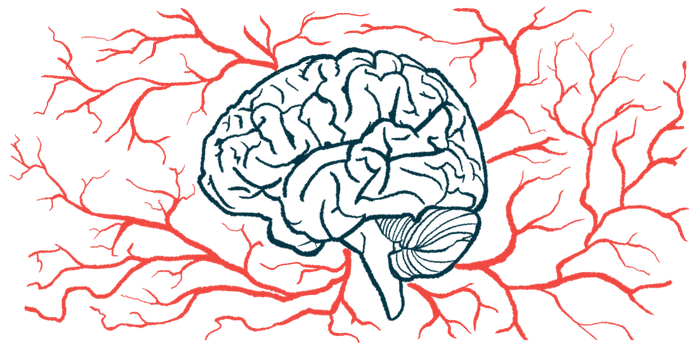Porphyria Attack Leads to Reversible Stroke in Woman, 28: Case Report
Blocked blood flow to brain led to stroke for AIP patient in France

A young woman in France experienced a stroke as a reversible neurological consequence of an acute intermittent porphyria (AIP) attack that blocked blood flow to the brain, according to a recent case report.
“The findings in our patient document reversible arterial narrowing” that caused the blood flow to be blocked, the researchers wrote, noting that all of the woman’s other test results came back negative.
The report was published in the European Journal of Case Reports in Internal Medicine, titled “Reversible Cerebral Vasospasm in Acute Intermittent Porphyria: A Case Report and Review of the Literature.”
The most common form of acute porphyria, AIP is caused by mutations that disrupt the production of an enzyme called porphobilinogen deaminase (PBGD). PBGD is necessary for the production of heme, a molecule that helps transport oxygen through the body.
As a consequence, heme precursors called porphyrins build up to toxic levels, and not enough oxygen is transported to body tissues.
Like other acute porphyria types, AIP is characterized by sudden, severe attacks that can affect multiple organs, and most often cause severe abdominal pain. The brain and other components of the nervous system can also be affected, leading to neurological symptoms, including sensory changes, muscle weakness, hallucinations, or seizures.
A rare occurrence in a rare disease
In rare cases, AIP may be accompanied by a cerebral infarction, or stroke, in which adequate blood flow to the brain is disrupted, depriving it of oxygen. It has been suggested that the cause of these strokes is a narrowing (vasospasm) of the cerebral arteries that supply oxygenated blood to the brain.
In this report, researchers described the case of a 28-year-old Caucasian woman who experienced a reversible vasospasm associated with AIP.
The woman was initially treated at the hospital for abdominal pain and vomiting. She had no family history of porphyria, was a non-smoker, and had no known exposures to medications that might induce porphyria symptoms.
Her physical exam in the hospital was normal, and no neurological or visual deficits were observed. A CT scan, ultrasound, colonoscopy, and blood test parameters also were normal, except for a low blood sodium level.
A week later, the woman developed muscle weakness on the right side of her body, but her walking was not affected. She had no fever or headache.
Her doctors performed an electroencephalogram — a test that assesses the brain’s electrical activity — that revealed no signs of seizures. But an MRI of the brain showed signs of a stroke.
A cerebral angiography was then performed to identify problems with blood vessels in her brain. This test revealed a narrowing of the cerebral arteries, confirming the presence of a vasospasm.
The usual causes of vasospasms were ruled out. These included drugs, migraine, blood vessel inflammation, or a tumor of the adrenal glands that sit atop the kidneys. She also tested negative for connective tissue disorders, viral infection, heavy metal poisoning, and thyroid dysfunction.
A porphyria diagnosis was considered when her urine turned red after being exposed to light — a hallmark of the disease. Additional tests revealed the presence of elevated porphyrin levels, and an AIP attack was confirmed.
The woman was treated with heme arginate and a high carbohydrate diet, which led to an almost complete resolution of the vasospasm. At a four-year follow-up, she was living normally.
According to researchers, this case “supports the concept that cerebral infarct, possibly resulting from porphyria-induced vasospasms, may be an important cause of cerebral dysfunction during acute AIP attacks.”
Still, the team noted that the mechanisms underlying neurological complications of AIP remain poorly understood.
“The pathogenetic [disease-causing] mechanisms which lead to the neurological dysfunction have remained poorly understood, partly due to the lack of a suitable animal model of these rare disorders,” the researchers wrote.







